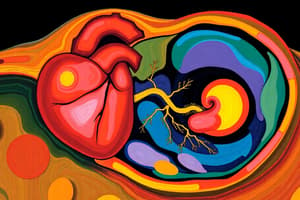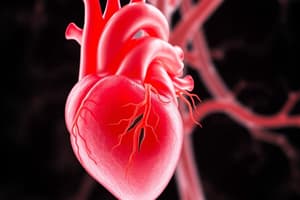Podcast
Questions and Answers
During fetal development, what is the primary function of the ductus arteriosus?
During fetal development, what is the primary function of the ductus arteriosus?
- To filter waste products from the fetal blood before returning it to the placenta.
- To shunt blood from the pulmonary artery to the aorta, bypassing the non-functioning fetal lungs. (correct)
- To direct blood from the right atrium to the left atrium.
- To carry oxygenated blood from the placenta directly to the fetal brain.
What is the immediate effect of clamping the umbilical cord and the newborn's first breath on the fetal circulatory system?
What is the immediate effect of clamping the umbilical cord and the newborn's first breath on the fetal circulatory system?
- Decreased systemic vascular resistance and increased right atrial pressure.
- Decreased pulmonary vascular resistance and increased left atrial pressure, leading to closure of the foramen ovale. (correct)
- Increased systemic vascular resistance and opening of the ductus arteriosus.
- Increased pulmonary vascular resistance and closure of the foramen ovale.
A child is diagnosed with a congenital heart defect that causes chronic hypoxemia. What clinical manifestation is LEAST likely to be observed?
A child is diagnosed with a congenital heart defect that causes chronic hypoxemia. What clinical manifestation is LEAST likely to be observed?
- Small stature for age.
- Increased tolerance to exercise. (correct)
- Motor and cognitive delays.
- Shortness of breath with exertion.
In a child with a ventricular septal defect (VSD), what physiological change directly leads to increased pulmonary blood flow?
In a child with a ventricular septal defect (VSD), what physiological change directly leads to increased pulmonary blood flow?
Why might a patent ductus arteriosus (PDA) cause increased workload on the left ventricle?
Why might a patent ductus arteriosus (PDA) cause increased workload on the left ventricle?
Which of the following is most likely to result in an increased risk of pulmonary hypertension in a child?
Which of the following is most likely to result in an increased risk of pulmonary hypertension in a child?
During the neonatal period, why is the shunting of blood minimal in atrioventricular canal defect?
During the neonatal period, why is the shunting of blood minimal in atrioventricular canal defect?
The pathophysiology of Tetralogy of Fallot is most significantly affected by which factor?
The pathophysiology of Tetralogy of Fallot is most significantly affected by which factor?
In Tetralogy of Fallot, a large VSD contributes to the pathophysiology in which way?
In Tetralogy of Fallot, a large VSD contributes to the pathophysiology in which way?
Why does cyanosis become apparent when the ductus arteriosus closes in an infant with Tetralogy of Fallot?
Why does cyanosis become apparent when the ductus arteriosus closes in an infant with Tetralogy of Fallot?
What is the primary anatomical defect in tricuspid atresia that leads to altered blood flow?
What is the primary anatomical defect in tricuspid atresia that leads to altered blood flow?
In tricuspid atresia, how does blood typically reach the pulmonary circulation?
In tricuspid atresia, how does blood typically reach the pulmonary circulation?
What is the primary hemodynamic consequence of coarctation of the aorta?
What is the primary hemodynamic consequence of coarctation of the aorta?
How does aortic stenosis primarily affect left ventricular function?
How does aortic stenosis primarily affect left ventricular function?
What is the most severe form of pulmonic stenosis?
What is the most severe form of pulmonic stenosis?
Why is a communication between the pulmonary and systemic circulation essential for survival in conditions like transposition of the great vessels?
Why is a communication between the pulmonary and systemic circulation essential for survival in conditions like transposition of the great vessels?
In total anomalous pulmonary venous connection (TAPVC), where do the pulmonary veins typically connect?
In total anomalous pulmonary venous connection (TAPVC), where do the pulmonary veins typically connect?
What is the primary anatomical defect in truncus arteriosus?
What is the primary anatomical defect in truncus arteriosus?
What anatomical abnormalities are characteristic of hypoplastic left heart syndrome?
What anatomical abnormalities are characteristic of hypoplastic left heart syndrome?
What congenital heart defect is characterized by a single vessel arising from both ventricles due to the failure of the truncus arteriosus to divide?
What congenital heart defect is characterized by a single vessel arising from both ventricles due to the failure of the truncus arteriosus to divide?
What hemodynamic abnormality is associated with Patent Ductus Arteriosus (PDA)?
What hemodynamic abnormality is associated with Patent Ductus Arteriosus (PDA)?
A child with a moderate Ventricular Septal Defect (VSD) is likely to exhibit which of the following clinical features?
A child with a moderate Ventricular Septal Defect (VSD) is likely to exhibit which of the following clinical features?
How does pulmonary stenosis impact blood flow in Tetralogy of Fallot?
How does pulmonary stenosis impact blood flow in Tetralogy of Fallot?
In coarctation of the aorta, where is the narrowing typically located, and what are the subsequent effects on blood pressure?
In coarctation of the aorta, where is the narrowing typically located, and what are the subsequent effects on blood pressure?
What is the primary cause of heart failure observed in children with congenital heart defects?
What is the primary cause of heart failure observed in children with congenital heart defects?
What is the general mechanism associating obesity to hypertension in children?
What is the general mechanism associating obesity to hypertension in children?
In hypoplastic left heart syndrome, why are a well-functioning right ventricle and the presence of a PDA or ASD essential for survival?
In hypoplastic left heart syndrome, why are a well-functioning right ventricle and the presence of a PDA or ASD essential for survival?
How can chronic hypoxemia affect the growth and development of a child with a congenital heart defect?
How can chronic hypoxemia affect the growth and development of a child with a congenital heart defect?
Flashcards
Cardio Genesis
Cardio Genesis
Heart development starts at three weeks, with major development between the fourth and seventh weeks.
Endocardial Cushions
Endocardial Cushions
These form the cardiac septum, parts of valves, dividing heart chambers, and help form mitral and tricuspid valves.
Ductus Venosus Function
Ductus Venosus Function
During fetal circulation, blood travels from the placenta to the fetal liver.
Fetal Blood Flow (Lungs)
Fetal Blood Flow (Lungs)
Signup and view all the flashcards
Birth Pressure Shift
Birth Pressure Shift
Signup and view all the flashcards
Foramen Ovale Closure
Foramen Ovale Closure
Signup and view all the flashcards
Ductus Arteriosus Closure
Ductus Arteriosus Closure
Signup and view all the flashcards
CHD Classification
CHD Classification
Signup and view all the flashcards
Heart Failure
Heart Failure
Signup and view all the flashcards
Hypoxemia
Hypoxemia
Signup and view all the flashcards
Left-to-Right Shunt
Left-to-Right Shunt
Signup and view all the flashcards
Patent Ductus Arteriosus (PDA)
Patent Ductus Arteriosus (PDA)
Signup and view all the flashcards
Atrial Septal Defect (ASD)
Atrial Septal Defect (ASD)
Signup and view all the flashcards
Ventricular Septal Defect (VSD)
Ventricular Septal Defect (VSD)
Signup and view all the flashcards
Atrioventricular Canal Defect (AVCD)
Atrioventricular Canal Defect (AVCD)
Signup and view all the flashcards
Defects Decreasing Pulmonary Blood Flow
Defects Decreasing Pulmonary Blood Flow
Signup and view all the flashcards
Tetralogy of Fallot
Tetralogy of Fallot
Signup and view all the flashcards
Tricuspid Atresia
Tricuspid Atresia
Signup and view all the flashcards
Obstructive Defects
Obstructive Defects
Signup and view all the flashcards
Coarctation of the Aorta
Coarctation of the Aorta
Signup and view all the flashcards
Aortic Stenosis
Aortic Stenosis
Signup and view all the flashcards
Pulmonary Stenosis
Pulmonary Stenosis
Signup and view all the flashcards
Transposition of the Great Vessels (TGV)
Transposition of the Great Vessels (TGV)
Signup and view all the flashcards
Total Anomalous Pulmonary Venous Connection (TAPVC)
Total Anomalous Pulmonary Venous Connection (TAPVC)
Signup and view all the flashcards
Truncus Arteriosus
Truncus Arteriosus
Signup and view all the flashcards
Hypoplastic Left Heart Syndrome (HLHS)
Hypoplastic Left Heart Syndrome (HLHS)
Signup and view all the flashcards
Coarctation of the Aorta: Blood flow
Coarctation of the Aorta: Blood flow
Signup and view all the flashcards
Heart Failure
Heart Failure
Signup and view all the flashcards
Study Notes
- Cardio Genesis initiates at three weeks, with most heart development occurring between the fourth and seventh weeks.
- The heart initially forms as two lateral in the cardio tubes.
- Around the fourth week, ventricles, the aortic arch, and the endocardial cushions develop.
- Endocardial cushions form the cardiac septum and parts of the valves, dividing all four heart chambers and aiding the formation of the mitral and tricuspid valves.
- Improper formation of cardiac cushions can lead to significant cardiac deformities.
- Blood travels from the placenta to the fetal liver through the ductus venosus to the inferior vena cava.
- Blood then flows to the right atrium, through the foramen ovale, to the left atrium and then to the left ventricle and the aorta.
- Two thirds of blood entering the heart flows to the head and upper extremity, providing higher oxygen concentration to the brain and coronary arteries.
- Blood returns through the superior vena cava to the right atrium.
- A small portion flows to the right ventricle and non-functioning lungs.
- Most blood bypasses the lungs, flowing through the ductus arteriosus into the descending aorta and returns to the placenta.
- Blood follows the path of least resistance due to high pulmonary vascular resistance that forces blood through appropriate shunts.
- At birth, lung expansion and decreased resistance, along with clamping the umbilical cord, shift pressure gradients.
- The left atrial pressure exceeds the right, causing the foramen ovale to close and fuse within the first month.
- Decreased pulmonary vascular resistance and increased arterial oxygen concentration cause the ductus arteriosus to close.
- Congenital heart defects are classified into four categories based on blood flow patterns, and clinical manifestations depend on these patterns.
- The two most common conditions are heart failure and hypoxemia.
Heart Failure
- Classified as an acquired condition.
- Occurs when the heart cannot meet the metabolic demands of the body, resulting from decreased myocardial function or excessive metabolic demands.
- Mechanisms in children are similar to adults.
- Pulmonary over circulation is a predominant cause associated with congenital defects.
- Manifestations include poor feeding and sucking, often leading to failure to thrive.
Hypoxemia
- Caused by any defect that allows desaturated blood to enter systemic circulation without passing through the lungs.
- Children with chronic hypoxemia are often small for their age.
- May display motor or cognitive delays.
- Are short of breath with exertion.
- Fatigue easily exhibiting exercise intolerance.
- Defects increasing pulmonary blood flow are left-to-right shunts.
- Depending on the degree, children can develop symptoms of heart failure.
- Blood flows from high pressure to low pressure, from the left heart to the right heart if a path is present.
- Can increase pulmonary circulation, leading to heart failure or pulmonary hypertension if the shunt is small and unrecognized.
- At birth, pulmonary vascular resistance and systemic vascular resistance are nearly equal, so shunting is minimal in a patent ductus arteriosus.
- As pulmonary vascular resistance falls, blood shunts from the aorta to the pulmonary artery, increasing pulmonary volume and left ventricle workload.
- The left ventricle pumps oxygenated blood twice.
Atrial Septal Defects (ASD)
- Classified into three major types based on location, formation, and associated abnormalities.
- Although there is a small pressure difference between the atria, it is enough to create a left-to-right shunt.
- Children are generally asymptomatic.
- Moderate to large shunts increase pulmonary blood flow.
- Pulmonary vascular changes can occur over time.
Ventricular Septal Defects (VSD)
- Communication between the ventricles.
- Clinical manifestations depend on the size of the defect.
- Small defects cause minimal circulatory changes.
- Moderate to large defects cause an enlarged pulmonary artery, left atrium, and left ventricle.
- Increased pulmonary vascular resistance and pulmonary hypertension can occur.
- Increased blood flow causes the pulmonary vascular bed to constrict and increase resistance; this causes pressure and becomes permanent over time.
- Shunting occurs from the left ventricle to the right ventricle following a pressure gradient, leading to multiple circulations through the pulmonary circulation for every systemic circulation.
Atrioventricular Canal Defect
- Anomalies in both the atria and the ventricular septum, as well as the AV valves.
- There are three types based on the cardiac components involved.
- Hemodynamic abnormalities depend on the components and level of the lesion.
- Shunting is minimal during the neonatal period when pulmonary vascular resistance is high.
- Once pulmonary resistance drops, there is a left-to-right shunt, increasing pulmonary blood flow and possibly causing heart failure.
Defects Decreasing Pulmonary Blood Flow
- Tetralogy of Fallot and tricuspid atresia.
- Involve obstruction to pulmonary blood flow and septal communications.
- The right ventricular outflow tract is obstructed, increasing right-sided pressures and causing a right-to-left shunt.
- This causes circulation of non-oxygenated blood, creating hypoxemia and cyanosis.
Tetralogy of Fallot
- Pathophysiology varies widely with the degree of pulmonary stenosis.
- The size of the VSD and the pulmonary and systemic resistance.
- The VSD shunt is usually large with turbulent flow.
- Direction is the difference between the pulmonary vascular resistance and the systemic vascular resistance.
- A patent ductus arteriosus creates a relief shunt to allow blood to become oxygenated.
- Cyanosis becomes apparent when the ductus closes.
- With a narrowing of the pulmonary outflow tract causing higher pressures in the right ventricle, the pressure can exceed the left ventricle pressure, and the VSD does not close as it should.
Tricuspid Atresia
- Results from no communication between the right atrium and the right ventricle.
- Also includes an atrial septal defect, hypoplastic or absent right ventricle, and enlarged mitral valve and left ventricle.
- Varying degrees of pulmonary stenosis.
- May be associated with transposition of the great vessels.
- Systemic blood returns to the right atrium via the superior and inferior vena cava and flows through the ASD to the left atrium, mixing with blood from the pulmonary circulation.
- The blood travels to the left ventricle and is pumped into systemic circulation through the aorta.
- Amounts flow through the ventricular septal defect into the hypoplastic right ventricle and then into the lungs.
Obstructive Defects
- Caused by anatomic stenosis in either the right or left outflow tracts.
- Results in pressure load on the affected ventricle.
Coarctation of the Aorta
- Narrowing of the aortic lumen impeding flow.
- Results in higher pressures proximal to the narrowing and lower pressures distally.
- Severe coarctation could reverse flow through a patent ductus arteriosus, sending blood back into the pulmonary circulation.
- Severity depends on whether the lesion is pre or post ductal.
- Post ductal lesions can be less severe, allowing blood to pass the brachiocephalic, left common carotid, and left subclavian arteries prior to the constriction.
Aortic Stenosis
- Narrowing of the left ventricular outflow tract, causing increased workload on the left ventricle, resulting in left ventricular hypertrophy.
- Manifestation depends on the degree of the lesion or defect.
Pulmonary Stenosis
- Narrowing of the pulmonary outflow tract, including thickening valve leaflets or narrowing of the pulmonary artery.
Pulmonary Atresia
- The most severe form of pulmonary stenosis.
- It involves complete fusion of the pulmonic valve.
Mixing Defects
- Dependent upon the mixing of pulmonary and systemic circulation for survival.
- Results in unsaturated systemic blood flow and cyanosis.
- Pulmonary congestion and hypertension occur due to preferential pulmonary blood flow, because of decreased pulmonary vascular resistance.
Transposition of the Great Vessels
- The aorta arises from the right ventricle, and the pulmonary artery arises from the left ventricle.
- Results in deoxygenated blood circulating through the systemic circulation and oxygenated blood repeatedly circulating through the pulmonary circulation.
- Typically incompatible with extra uterine life, unless some communication exists between the two circuits.
Total Anomalous Pulmonary Venous Connection
- Pulmonary veins connect to the right side of the heart.
- Directly or through one or more of systemic veins that drain into the right atrium.
- Very rare.
Truncus Arteriosus
- Failure of the truncus arteriosus to divide into the pulmonary artery and aorta.
- Results in a single vessel rising from both ventricles.
- Blood flows into this common artery, resulting in a mixing of pulmonic and systemic circulations.
Hypoplastic Left Heart Syndrome
- Abnormal development of the left-sided cardiac structures.
- Involves underdevelopment of the left ventricle, aorta, and aortic arch.
- Infants must have a well-functioning right ventricle.
- The presence of a PDA or an ASD for survival.
Pediatric Acquired Heart Diseases
- Children diagnosed with hypertension often have an underlying disease.
- The prevalence of hypertension in older children has increased.
- Many factors influence blood pressure in children, including smoking, obesity, and sedentary lifestyles.
- Obesity is one of the most important factors in the prevalence of hypertension in children.
- Mechanisms influence blood pressure in children, including modifiable and non-modifiable risk factors.
Studying That Suits You
Use AI to generate personalized quizzes and flashcards to suit your learning preferences.



